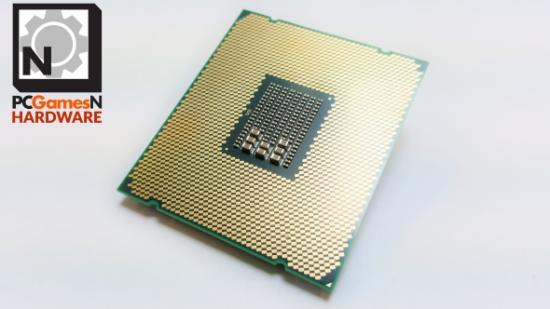We’ll get straight to the point: the i7 6800K is the first genuinely affordable HyperThreaded six-core CPU ever made, delivering $1,000 CPU performance for less than half the price.
Intel have got the current CPU game sewn up, but our in-depth guide to the new AMD Zen processors is a glimpse into a potentially very different future.
And with it, CPU core count seems to finally be moving forwards. Sure, Intel released a 10-core processor this year, but it’s an insane amount of money and just plain irrelevant to pretty much everyone on the planet.
But for the longest time our mainstream processors have been stuck at the quad-core level. You could argue AMD made advances from Bulldozer onwards – offering eight-core processors for a reasonable price – but in reality the core difference between an octo AMD and a HyperThreaded Intel quad is more semantic than technical. Both are essentially CPUs with four cores but different takes on boosting concurrent processing threads.
That’s not to say their relative performance is anywhere near the same. Intel have AMD utterly hosed in terms of speed, so if you want the best processors it’s Intel or nothing. And it’s that situation which is behind the core stagnation of our desktop processors. AMD is not currently competitive enough for Intel to really push the envelope with the CPUs that go into our standard gaming rigs.
C’mon Zen, we’re all rooting for you, buddy.
And so we’ve only seen a move beyond four cores in the high-end desktop (HEDT) world, where the 10-core, 20-thread i7 6950X reigns supreme. But in recent years the lower-priced end of Intel’s HEDT range has brought higher core counts tantalisingly within reach of us normal PC-owning mortals.
The $440 (£400) Intel Core i7 6800K is the logical progression of that trend – a six-core, 12-threaded processor that’s only $100 (£100) more expensive than the very top of the Skylake CPU tree, the quad-core i7 6700K. It’s also a chip that’s able to give last generation’s $1,000 Core i7 a run for its money.
If you’re an impatient sort, click below to be taken directly to architecture info, our benchmark data, and that all-important out-of-10 score:
-
Intel Core i7 6800K architecture
-
Intel Core i7 6800K benchmarks
-
Intel Core i7 6800K performance
-
Intel Core i7 6800K verdict
Intel Core i7 6800K specs
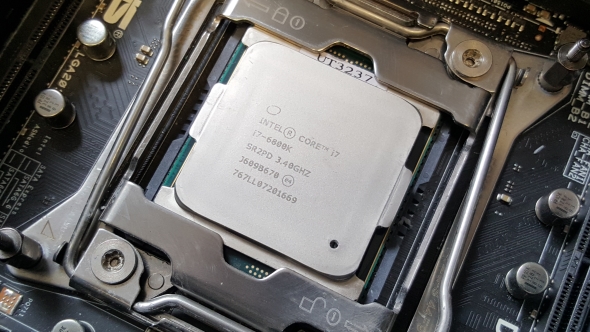
The all-important spec is that core/thread count. With six HyperThreaded cores the Core i7 6800K comes with 12 threads of processing power, allowing it to chew through a whole lot of serious number-crunching without breaking sweat. And as we move into a future where our game engines are increasingly comfortable spreading the load across multiple cores, with the likes of Vulkan and DirectX 12 offering tangible speed bumps, that higher thread count ought to come into play. But there are other important numbers which make this a great chip for a high-end gaming rig.
The number of PCIe 3.0 lanes coming directly out of the CPU itself means the 6800K is a better choice for a multi-GPU machine than a 6700K Skylake chip. This higher-end option comes with 28 lanes versus the Skylake’s 16 lanes. That’s not going to give you enough to allow for two GPUs running in full x16 configuration, but with both graphics cards operating in x8 PCIe mode there are still enough lanes left for a PCIe-attached SSD to plug directly into the CPU itself. It also means you can create a three-way GPU setup all connected straight into the processor’s onboard PCIe controller.
With the 6700K, on the other hand, the full complement of 16 processor-attached PCIe lanes will be taken up by a twin GPU setup, pushing PCIe SSD control onto the motherboard. In real terms that in itself is not a massive issue right now, but as SSDs demand more and more bandwidth it could become a bottleneck.
The other important numbers are the core and Turbo clockspeeds. With the Core i7 6800K running at a base of 3.4GHz and a Turbo speed of 3.8GHz it’s not too far behind the 6700K at peak performance and comfortably ahead of the pricier 5960X and 6950X. And thanks to Intel’s historic overclocking headroom you can easily top 4GHz to deliver the single-threaded CPU performance existing game engines still crave.
Intel Core i7 6800K architecture
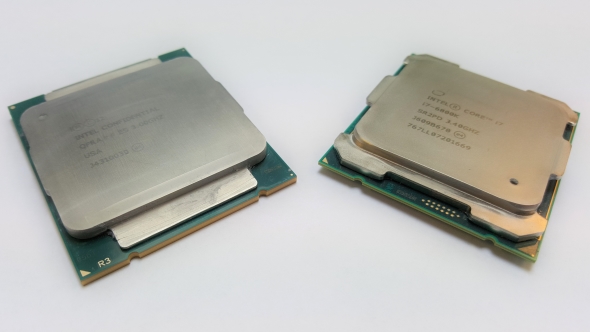
The six-core 6800K, despite using the same 6000-series numbering as the 6700K, is using a completely different CPU architecture. This chip is based on the Broadwell-E design released earlier this year rather than the Skylake architecture which appeared last year. Intel have kept their HEDT and mainstream processors a generation apart for years, so even though it was released later, Broadwell-E is actually an older CPU design than Skylake.Though that separation is set to change next year as Skylake-X rolls around alongside Kaby Lake-X.
Confused? Yeah, Intel don’t like to make things simple.
Broadwell-E is simply a die-shrink of the older Haswell-E architecture, dropping down from the 22nm transistor node to the current 14nm standard. It follows Intel’s tick-tock model where a die-shrink precedes a broader architectural revision – which is what Skylake-X will bring next year.
That means there is actually little different from the Haswell-E generation apart from officially supporting DDR4 memory up to 2,400MHz in place of the 2,133MHz ceiling of the previous generation. And, speaking of memory, compared with the standard desktop chips there’s a huge amount more bandwidth available to the HEDT platforms. The high-end Intel processors use quad-channel DDR4 – because of their server roots – instead of the dual-channel setup of the mainstream desktops. That doesn’t quite double the memory bandwidth, but it’s not that far off.
Intel Core i7 6800K benchmarks


Intel Core i7 6800K performance
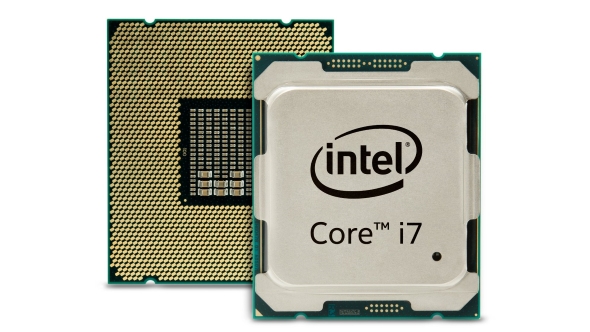
No matter which CPU you put it up against the Core i7 6800K is impressively powerful. If you look at its relative performance compared with the Skylake-based 6700K it’s got it beat all ends up in the straight processing stakes. Those extra cores and threads push it out well ahead in anything that takes account of multi-threaded workloads. And in gaming terms too it’s got the goods thanks to that relatively high Turbo clockspeed.
In the CPU-intensive Total War: Attila benchmark the 6800K is well ahead and the same goes for the DirectX 11-based 3DMark Firestrike test. Things are a little more even with the DirectX 12 version of Rise of the Tomb Raider, with the 6700K actually posting a microscopic lead.
And because it’s an Intel K-series processor there’s a fair amount of overclocking headroom available too. It’s not quite capable of the same clockspeeds as the Skylake chip when its multipliers are tweaked – I managed a healthy 4.8GHz overclock with the 6700K – but I was able to get a rock-solid boost to 4.3GHz with our 6800K sample. At those speeds it really kills it in the benchmark stakes.
And that’s where things get really interesting when compared with the still super-expensive Core i7-5960X too. That was the $1,000 pinnacle of Intel’s Haswell-E generation, but with the 4.3GHz boost the 6800K is able to make up for its two-core shortfall and almost match the more expensive chip in our testing. That’s a hell of a showing for a CPU which is edging down towards the more standard desktop processor pricing.
That’s not to say it isn’t still a huge amount of money to spend on chip you’re going to have as the number-crunching heart of your gaming rig. But mainstream six-core CPUs are still a long way from hitting our desktops – there is a vague rumour the 10nm Cannonlake silicon might appear in six-core trim, but even that is very doubtful.
And as good as the 6800K undoubtedly is though it doesn’t change the fact that we recommend the excellent Intel Core i5 6600K as the go-to chip for most people’s gaming rig. At $245 (£220) the i5 is fantastic value and will unlock pretty much all the pixel-pushing potential of any GPU attached to it. Single-core performance is still the metric most games engines are built on and the 6600K has that in abundance.
Intel Core i7 6800K verdict
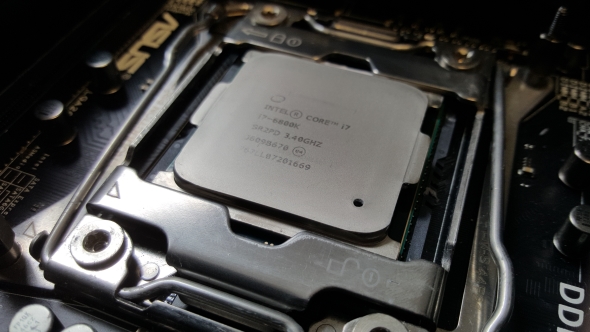
Everything else aside, the Core i7 6800K is the best-value six-core processor ever made and precious few corners have been sanded off to make it fit into its $440 (£400) price point.
For certain usage cases though the extra $100 (£100) you’d be spending on the 6800K over the 6700K actually makes sense. For high-end gaming rigs, sporting multiple graphics cards, the Broadwell-E chip is a great choice especially in terms of a little bit of extra future-proofing for your pricey build. When you’re talking about a full system build, with a pair of GTX 1080s doing the graphical grunt work, that six-core price premium becomes far easier to swallow.
And if you have any interest in video-editing, or other creative exercises requiring a lot of CPU horsepower and memory bandwidth, the 6800K suddenly becomes astounding value. There is, of course, the fact that the platform as a whole is a bit more expensive. X99 motherboards are generally more expensive than their Z170 compadres, though the price of DDR4 memory has dropped considerably in recent times.
When you want something a little more special from your gaming rig, or want to build something seriously high-end, with multiple GPUs and workstation-like processing and memory performance, Intel’s 6800K is a real star of a chip.
